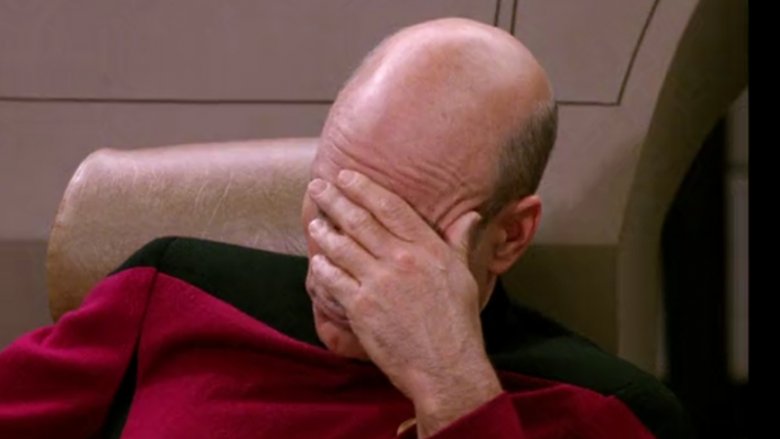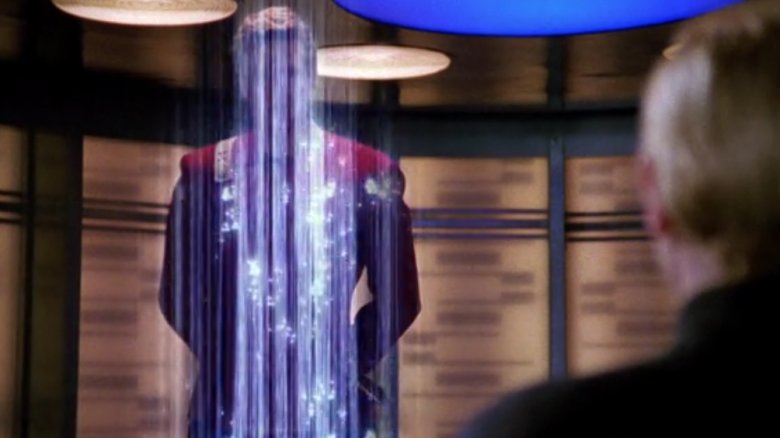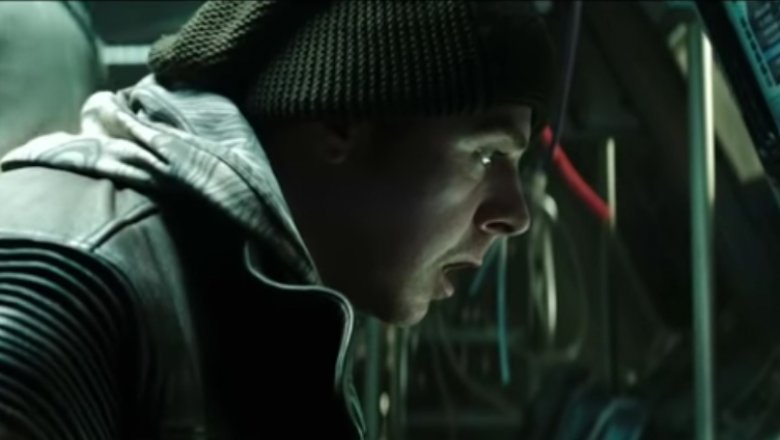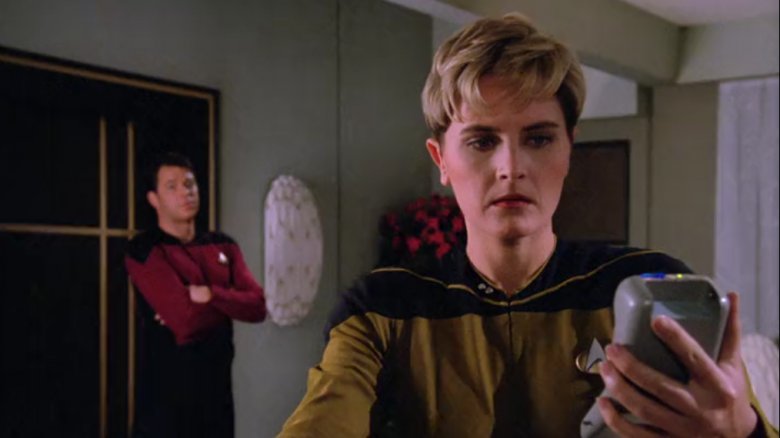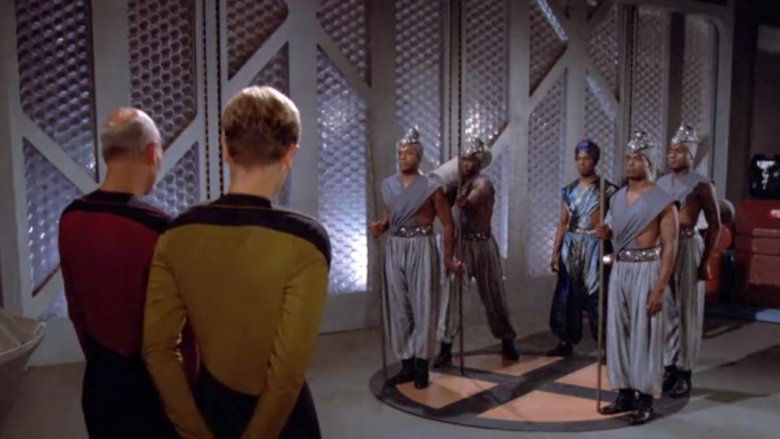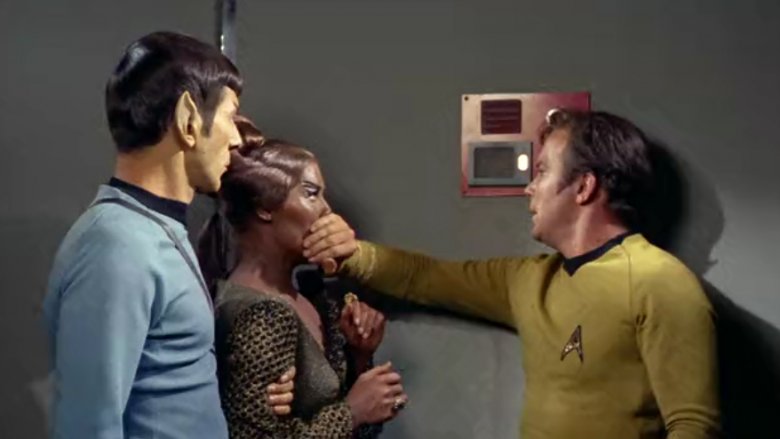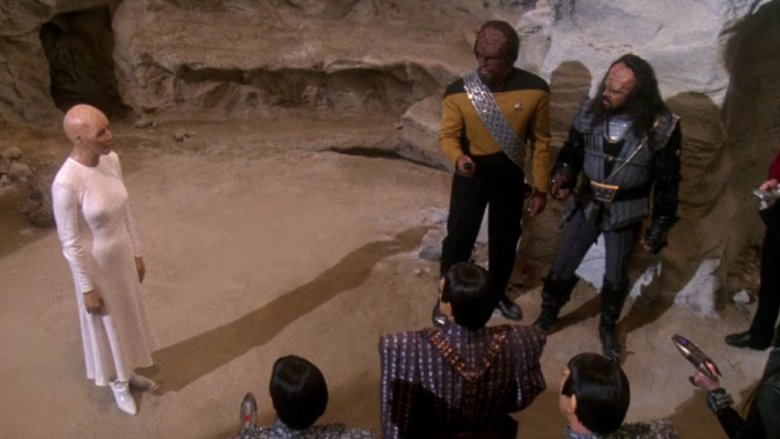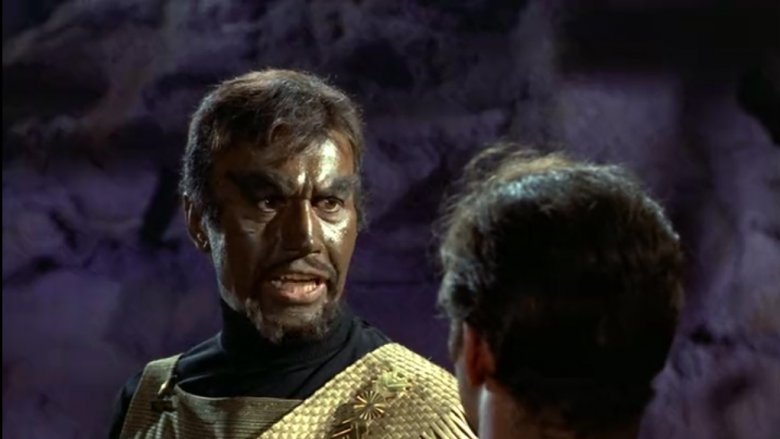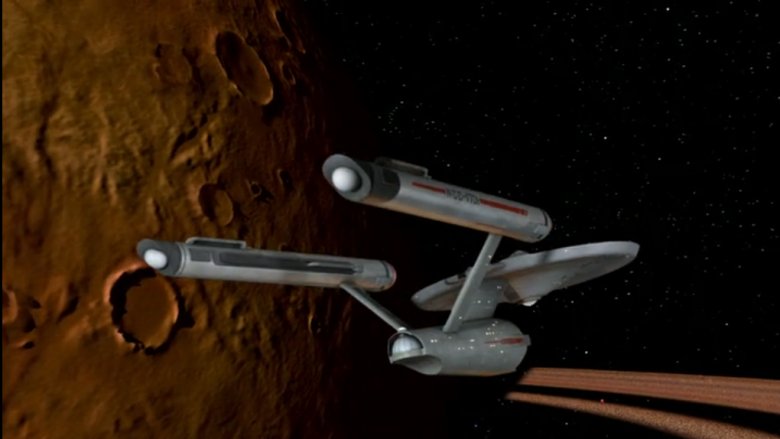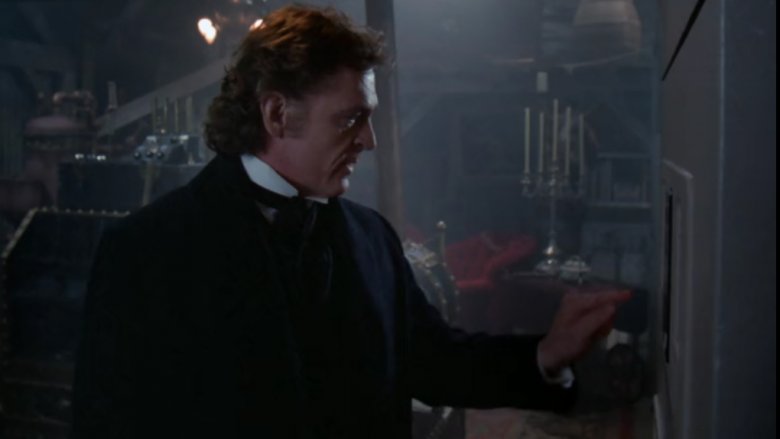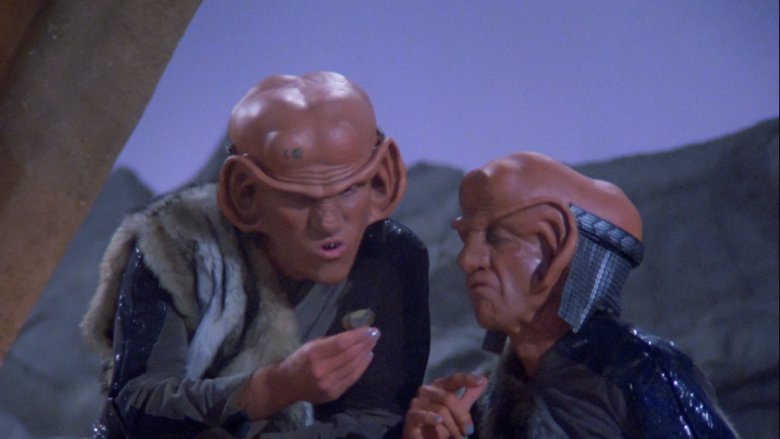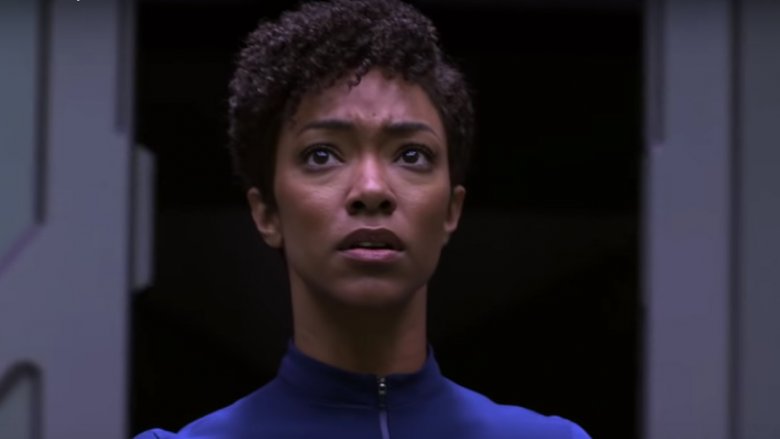Messed Up Things You Didn't Realize About Star Trek
We may receive a commission on purchases made from links.
"Space," we're told, is "the final frontier." It's provocative imagery, isn't it? The idea of one final horizon to strive toward. It also, given a moment's consideration, brings to mind the fact that all of the other frontiers in human history have been mired in death, horror, and mountains of human error.
And Star Trek, even across more than five decades, seems at least subconsciously aware of that. Look past the technicolor mini skirts of the original series and the less bright but equally noticeable male mini skirts of Next Generation and you'll see a world whose borders are marked by a thick outline of terror. From agonizing death to low-grade embarrassment, the entire spectrum of negative human experience can be found in the show's cannon. Here's a look at some of the most mindbogglingly upsetting stuff going on in the background of one of history's most optimistic works of fiction.
Star Trek's transporter nightmare
It's an important facet of everyday life on board a starship: when time is of the essence and there's not a second to lose, you use the transporter to get you from point A to point B. Other times, you just do it because you don't feel like walking all the way to the shuttlecraft bay. Heck, sometimes you might even do it just to get to the shuttlecraft bay. In any case, you're probably dying and cursing the universe with a computer-generated genetic twin of yourself every time you say "energize."
As has been pointed out by plenty of horrified fans over the years, the use of the Star Trek transporter system is an existential nightmare. The nuts and bolts of it are as follows: the ship's computer scans your molecular makeup, then converts your mass into energy which it moves from one place to another. The energy is then reconstituted into matter that's frequently-but-not-always in the shape of you. In essence, the person that steps into a transporter is vaporized and then a near-perfect facsimile comes out the other end. The only thing separating this procedure from the third act of The Prestige is that the Enterprise has a better system for getting rid of all the clutter that would be left behind by the bodies. No wonder Bones hated the things so much.
That time Scotty killed a dog in Star Trek
There are two equally important truisms in screenwriting that you need to know before we continue. Number one: the dog always has to survive. Number two: nobody liked Star Trek: Enterprise, so screw it.
Maybe that second part isn't fair. Enterprise had some genuinely fascinating aspects, especially as the series progressed and became the most hastily cancelled entry in the franchise since the original series. The ship's nascent tech was unreliable and still developing, leading to dramatic tension. Phasers were a relatively fresh invention, the transporters were an even bigger invitation to body horror than they wound up being in the future, and Captain Archer, bless his heart, brought a beagle named Porthos on board. Everyone likes a beagle.
Which is why it was just so weirdly creepy when Simon Pegg's iteration of Scotty in the 2009 reboot movie said, in a moment of pure J.J. Abrams nostalgia winkery, that he'd straight up slaughtered that dog. It's a blink-and-you'll-miss-it moment, but when Montgomery Scott is explaining why he wound up stranded on frozen planet, he says that he was being punished for, erm, "losing" one Admiral Archer's beagle during a test of a transporter hypothesis. Ladies and gentlemen, your secondary protagonist.
Sort of everything about Tasha Yar
If you go back and rewatch the first couple of seasons of Star Trek: The Next Generation, you'll probably do so with the rose-colored glasses of optimism afforded when getting stoked on revisiting a show from when you were younger. Maybe you'll have forgotten some of the jankier aspects of the early days of the series, like how wildly uncomfortable those uniforms looked or how much scenery John de Lancie managed to chew. And maybe, if you're very lucky, you'll have blanked out Tasha Yar in every aspect besides "she died pretty quick." (By the 23rd episode, if you're interested.)
So here's a friendly reminder to anyone out there feeling bright-eyed and eager to show TNG to their friends who've never seen it before. The Tasha Yar character has aged tremendously poorly. No subject is evergreen, but the frequency with which Denise Crosby's security chief brings up growing up on a planet full of "rape gangs" in her day-to-day work conversations (which she does in both "The Naked Now" and "Where No One Has Gone Before" in season 1) is equaled in uncomfortability only by how dead her eyes are every time she talks about it. There was also that time in "Code of Honor" when she was kidnapped for the purposes of forced marriage and felt just super flattered by it. Say what you want about Troi, but at least she wasn't a walking trigger warning.
Star Trek's claim of "no racism in the future" may have been optimistic
Gene Roddenberry had a bright and glorious vision of humanity's future: disease would be a rarity. Interpersonal conflict a thing of the past. And racism? There would be no more racism. It's a beautiful thought. But as anybody who's watched their grandpa get scotch drunk at Thanksgiving can tell you, contemporary ideas of what "no more racism" looks like don't always mesh with the ones from the 1960s.
That's why it gets super jarring when the totes woke world of Star Trek accidentally bumps up into race issues more complex than "surely we can learn to get along with people who have different foreheads than us." In the Next Generation episode "Code of Honor," the crew meets a society of people seemingly pulled out of a problematic 1930s-era Bugs Bunny cartoon about African tribes, complete with actual spears. Or there was the Voyager episode "Caretaker" where Tom Paris, caught in a pickle with a Native American first officer, asked if he had the ability to fix the situation by turning into a bird.
Star Trek's claim of "no sexism in the future" may have been optimistic
And then there was the sexism. In a utopian society where equality is the watchword, it's amazing how much time is spent on worlds where women are, scientifically speaking, just the worst. The Original Series stuff is, predictably, pretty out there. In an episode of the same name, an alien named Elaan of Troyius (the on-the-nose wordplay names were a whole other problem) decides that she'd like herself a sweet new Enterprise to take over, to which Kirk responds by threatening, and this is true, to spank her. Luckily that never comes up again and oh wait, no, it does. She space roofies the captain and then inquires about that whole "spanking" thing he brought up earlier. The future might be female, but it's written by adolescent boys.
This sort of misogyny occasionally pops its head out throughout the franchise. Kirk meets a woman in the second season episode "The Gamesters of Triskelion" who's so mentally stunted that he has to explain what "freedom" means to her. And yes, they hook up. In the last episode of the series, it's made explicitly clear that women can't be Starfleet captains since they're too emotional. In TNG's "Angel One," the crew visits a planet run by women, and the place is a full-on disaster.
Luckily, by the time the series rebooted in 2009, sci-fi had advanced to the point where equality was a reality and women were treated like human beings and no, just kidding, there's Alice Eve in her underpants for no reason.
Gene Roddenberry's keen interest in Star Trek going to bone town
Gene Roddenberry, the driving force behind Star Trek, was a compelling and complicated guy. He was, by all accounts, passionate about his work, an Olympic-level boozehound, and a powerhouse of a womanizer. His professional devotion shines through his body of work. His love of sipping hooch is apparent whenever Scotty waxes poetic about getting smashed. And as for the part where he was what doctors refer to as "real nasty?" Well, Roddenberry may have been the first content creator to write and publish adult fan fiction about his own creations.
It's no secret that everyone on the original Enterprise (except, ironically, Bones) was pretty well down to clown with whoever they ran into, and that probably has as much to do with human nature as it does with the fact that you can just replicate antibiotics in the future. But for the obsessively curious and, not to kink shame, but super weird fan of the show, there's also that LP that Roddenberry produced in the 70s where he (Roddenberry) interviews Spock's dad (a fictional character) on the subject of Vulcan mommy-daddy time.
It also seems worth mentioning that it took Next Generation all of two episodes to get to an "everybody's banging" story with "The Naked Now" and that you could cut the subtext of the V'Ger ship from Star Trek: The Motion Picture with a dull, dull knife.
Star Trek's mysteries of the universe, spaced
One of the most exciting concepts in the Star Trek universe is the idea that, in a post-scarcity society, the highest goal is no longer the attainment of wealth or glory, but the contribution of new knowledge to your society. Entire starships are sent out into the unexplored masses of the galaxy with the express intention of exploring, seeking out new worlds, and boldly going. Sometimes, things go according to plan. Sometimes they go so according to plan that information is uncovered which could fundamentally change the very way existence is perceived. And on those rare occasions, Star Trek characters kind of shrug it off and move on with their Tuesday.
For example, in the TNG episode "The Chase," we finally get an answer to the question "why does every sentient race look like a group of struggling human actors with weird foreheads?" It turns out that all humanoid life in the Alpha quadrant was created eons ago from the genetic material of a shared ancestor, doomed by time. In this single revelation, all of history, philosophy, and religion are changed forever. And what happens next?
Hard to say, because the next week was a "Riker gets tortured" episode and they never really came back to the now-defined meaning of existence after that.
Star Trek's Klingon backstory just can't catch a break
Klingons, what's up with your faces? The changing appearance of Klingons was one of the great mysteries of Star Trek for decades; why did they look like spray tanned Renaissance Fair employees in the Original Series, then suddenly got all bumpy in the movies and sequel series?
Fans finally had the differences acknowledged onscreen in the Deep Space Nine episode "Trials and Tribble-ations", but it didn't really answer any questions. Viewers later got their first official answer in the Enterprise episode "Divergence." It turns out that a century before Kirk and company's adventures, Klingons, seen with their characteristic cranial ridges, experimented with genetic augmentation to try and make better Klingons. The result was a fraction of the population being physically deformed by a mutated genetic virus. It wasn't the most popular explanation, to say the least.
So why do the Klingons in Discovery look like orcs that got their faces shoe polished? The official off-screen explanation is that these Klingons are just different Klingons that we haven't seen before. And never see again. Of course.
To boldly go (away) in Star Trek
The crews of the various Enterprises are like most TV protagonists. They're traveling through, happy to help where they can. But once they've helped, they're gone, and the people whose lives they've changed are left to deal with their new reality unguided. "So what?" you might ask. "Let 'em pull themselves up by their bootstraps."
But it's not always that simple. In "The Gamesters of Triskelion," Kirk meets (and again, totally hooks up with) a woman who doesn't understand what "freedom" means. And it's not like that's the only gap in her education. Jimmy T. has to mansplain whole sections of the human emotional spectrum to her. She's been a slave her entire life. At the end of the episode, she asks if she can come with him, to which he more or less responds, "Nah, you stay here. You'll figure it out."
The tragedy of a hero in an adventure program is that at the end of 42 minutes plus commercials, they're on their merry way. They say goodbye to this week's guest performers and head off into the sunset. Episodic television is episodic. What are you going to do? Abandon a race of kidnapping victims with child minds, that's what. And frankly, it happens a lot. Maybe the best Star Trek movie ever, The Wrath of Khan, was based around the fact that these people are Audi as soon as they've dotted the i's in their log entries.
Now you're playing with godlike power
Readers of a certain age might recall what it was like to beg their parents for a Nintendo 64 back in the day. You remember the drill: your parents would say "it's too expensive" and you'd counter with "but please?" and your parents would say "you won't do your homework" and you'd say "I'll totally do my homework" and your parents would say "but this technology has a history of creating sentient artificial life with a drive to destroy everything we love" and you'd say "but Banjo-Kazooie!"
That's the argument that's being had every time someone boots up the holodeck on Star Trek. It's a segment of future tech that even the crew seems to have a hard time fully understanding. It creates entire virtual worlds by constructing hard light holograms, which has to be a pretty wild power drain. And when it acts up, which it does with predictable regularity, it creates self-aware, often malicious life that has, on more than one occasion, tried to kill everyone on board the Enterprise.
That said, it's also important to keep the crew entertained. Or, to put it another way, "but Banjo-Kazooie."
Who's flying this thing?
Many of the myriad species of Star Trek are arguably all personifications of negative human characteristics. The Klingons represent rage, the Borg represent mindless conformity, the Breen represent that dark impulse to wear hats that are a little too much, etc. When it's handled right, it makes for some stellar morality storytelling, with manifestations of the enemies of the better angels of human nature meaning that the human race can actually fight its demons.
Then there are the times when it's handled badly. The Ferengi, for example, started out in "The Last Outpost" as a species of stunted scenery chewers with the body awareness of a third year interpretive dance major. They took a good long minute to figure themselves out, but even when they did, they settled into the role of cartoonish space Scrooges, loving money so much that they literally worshiped it (as seen in DS9's "The Nagus.")
In both iterations, the audience is left wondering how the heck these creatures are keeping their ships running. If your entire crew is made up of Lord of the Rings orcs who drool at the thought of making a quick sawbuck, who's in charge of, say, keeping the life support online?
Star Trek: Discovery, in general
Remember back when Star Wars used to get a bunch of flack for telling its story out of order? How releasing the movies 4, 5, 6, then 1, 2, 3 seemed unnecessarily complicated? And remember how right after that, Star Trek said, "Hold my Romulan ale?"
Around the end of the 90s, the producers on Star Trek decided to head into prequel territory, making a show that takes place over a hundred years before the Original Series. In 2017, they kept puttying in the gaps in the timeline with Star Trek: Discovery, a series set just before Kirk and Co. show up. One of the biggest issues this raised was "how come everything taking place before Original Series looks so much more advanced than the junk from the 60s show?"
See, within the show, the Starship Discovery has touchscreen computers, holographic communications systems, and most importantly, an organic propulsion system capable of transporting ships instantly to any point in the galaxy. At the end of the second season, the crew decides that last part is something they should keep under wraps forever, so it's a good thing nobody in Starfleet ever wound up stranded tens of thousands of light years from home.
